Minimalist Living Room Design: A Guide to Simplicity and Functionality
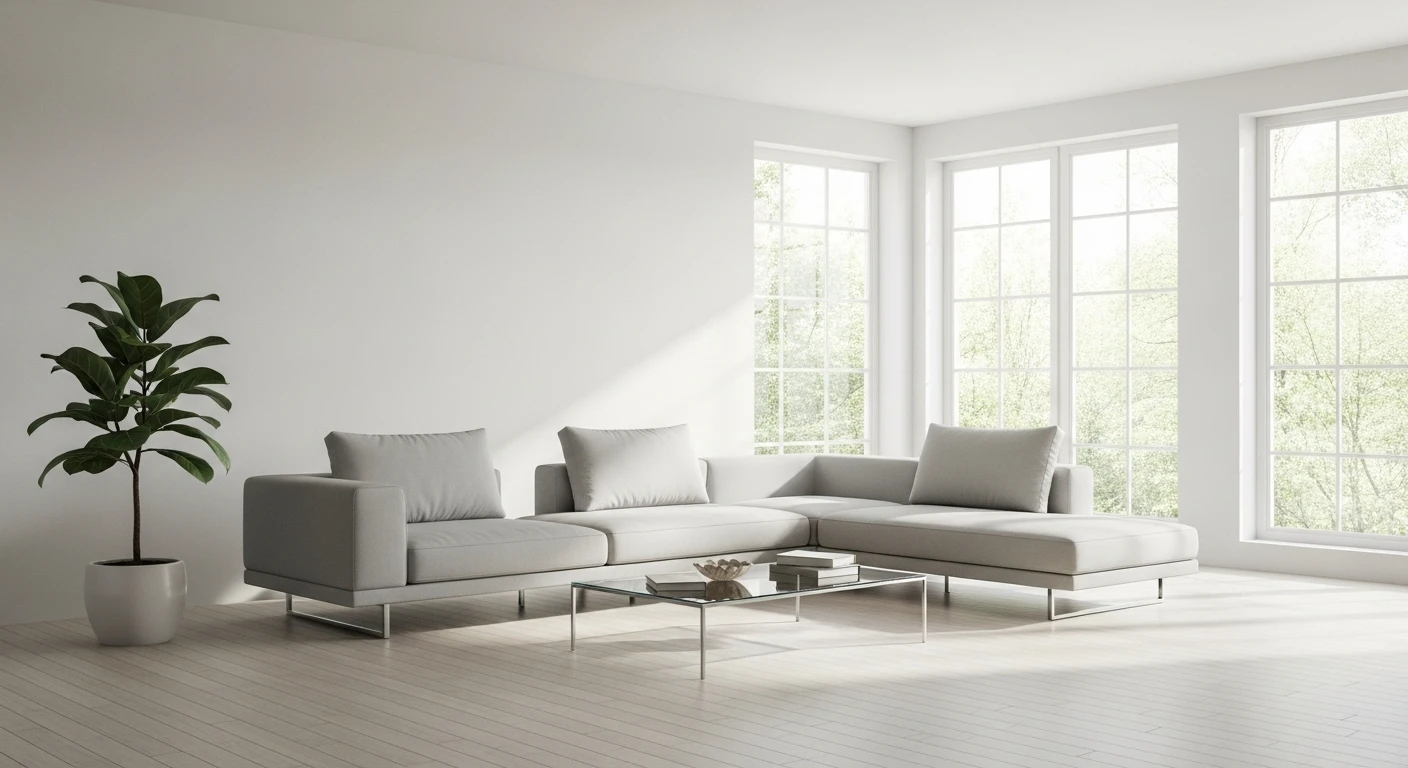
In our increasingly cluttered world, the minimalist living room has emerged as a sanctuary of calm and purposeful design. This approach to interior design champions the philosophy that “less is more,” creating spaces that are both visually stunning and incredibly functional. Whether you’re looking to declutter your existing space or design a new living room from scratch, understanding the principles of minimalist design can transform your home into a peaceful, organized haven.
What is Minimalist Living Room Design?
Minimalist living room design is a design philosophy that emphasizes simplicity, functionality, and the intentional use of space. It’s not about having an empty room or living with the bare minimum – rather, it’s about curating your space to include only what serves a purpose or brings joy. This design approach focuses on clean lines, neutral color palettes, and high-quality pieces that stand the test of time.
The minimalist movement originated from the Japanese concept of “Ma,” which refers to the use of emptiness or negative space as a design element. This principle recognizes that empty space itself can be beautiful and functional, allowing the mind to rest and the eye to appreciate the carefully chosen elements within the room.
Core Principles of Minimalist Living Room Design
1. Quality Over Quantity
In minimalist design, every piece of furniture and decor should earn its place in the room. Instead of filling your space with multiple inexpensive items, invest in fewer, high-quality pieces that will last for years. A well-made sofa in a timeless design will serve you better than multiple trendy pieces that quickly go out of style.
2. Functional Beauty
Every item in a minimalist living room should serve a purpose, even decorative elements. A beautiful ceramic vase might hold fresh flowers, while also serving as a striking focal point. Storage ottomans provide seating while hiding clutter, and floating shelves display books while maximizing floor space.
3. Clean Lines and Simple Forms
Minimalist furniture features clean, straight lines and simple geometric shapes. Avoid ornate details, excessive curves, or busy patterns that can make a space feel cluttered. Instead, opt for furniture with sleek silhouettes that create a sense of order and calm.
4. Intentional Negative Space
Empty space is not wasted space in minimalist design. Strategic use of negative space allows the eye to rest and makes the room feel larger and more open. Don’t feel compelled to fill every corner or wall – sometimes, leaving space empty is the most powerful design choice.
Essential Elements of a Minimalist Living Room
Color Palette: The Foundation of Serenity
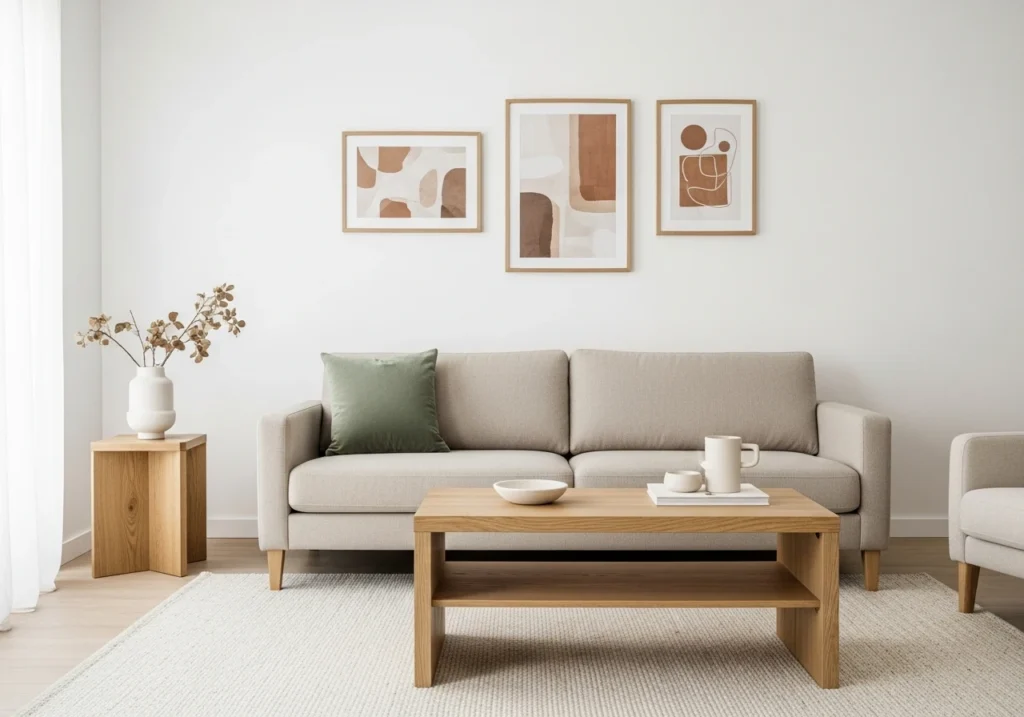
The color palette forms the backbone of any minimalist living room. Neutral colors are the hallmark of this design style, creating a calm and cohesive atmosphere that never goes out of style.
Primary Neutral Colors:
- Crisp whites and off-whites
- Warm beiges and creams
- Soft grays in various tones
- Natural wood tones
Accent Colors: While neutrals dominate minimalist spaces, strategic use of accent colors can add depth and interest. Consider incorporating:
- Muted earth tones like sage green or dusty rose
- Deep, rich colors in small doses (navy blue, charcoal, or forest green)
- Natural colors that complement wood and stone elements
The key is restraint – use accent colors sparingly and consistently throughout the space to maintain visual harmony.
Furniture Selection: Form Meets Function
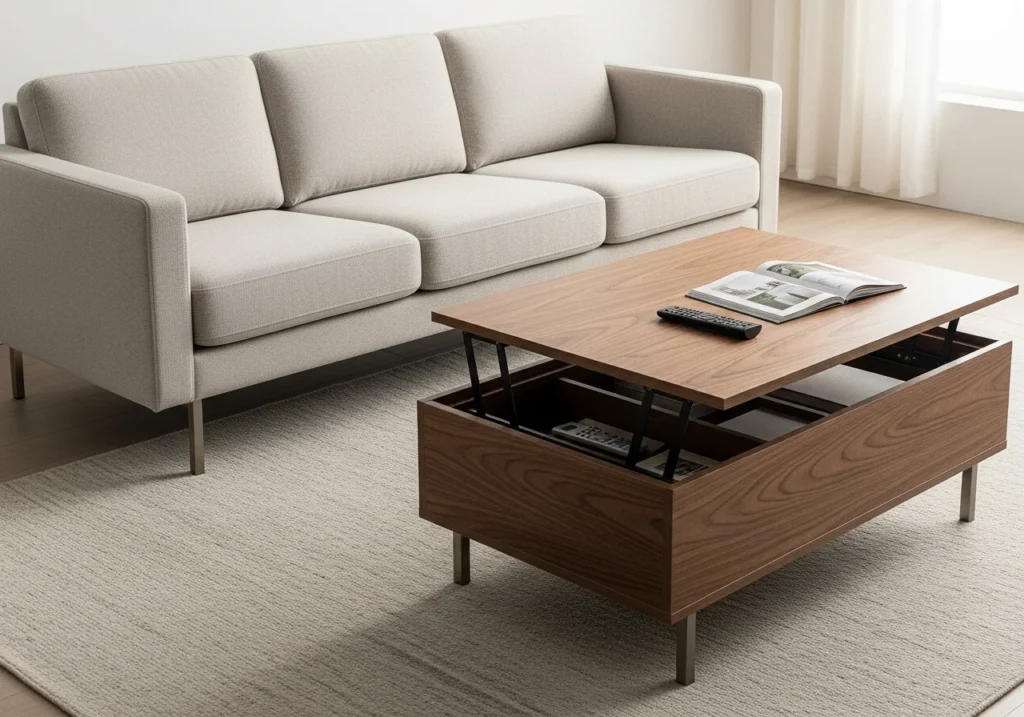
Choosing the right furniture is crucial in minimalist living room design. Each piece should be carefully considered for both its aesthetic appeal and practical function.
The Perfect Minimalist Sofa: Your sofa is likely the largest piece in your living room, making it a focal point that sets the tone for the entire space. Look for:
- Clean, straight lines or gentle curves
- Neutral upholstery in durable fabrics
- Proportions that fit your space without overwhelming it
- Quality construction that will last for years
Coffee Tables and Side Tables: Select tables with simple geometric shapes and minimal ornamentation. Materials like glass, metal, and natural wood work particularly well. Consider pieces that offer hidden storage to maintain the clean aesthetic while providing practical functionality.
Seating Options: In addition to your main sofa, consider adding:
- A pair of sleek accent chairs
- A minimalist bench that doubles as extra seating and storage
- Floor cushions for flexible, casual seating that can be stored away when not needed
Storage Solutions: Storage is essential in minimalist design, but it should be as invisible as possible. Opt for:
- Built-in shelving that blends with the walls
- Storage ottomans and benches
- Sleek media consoles with closed storage
- Floating shelves that don’t take up floor space
Lighting: Creating Ambiance with Intention
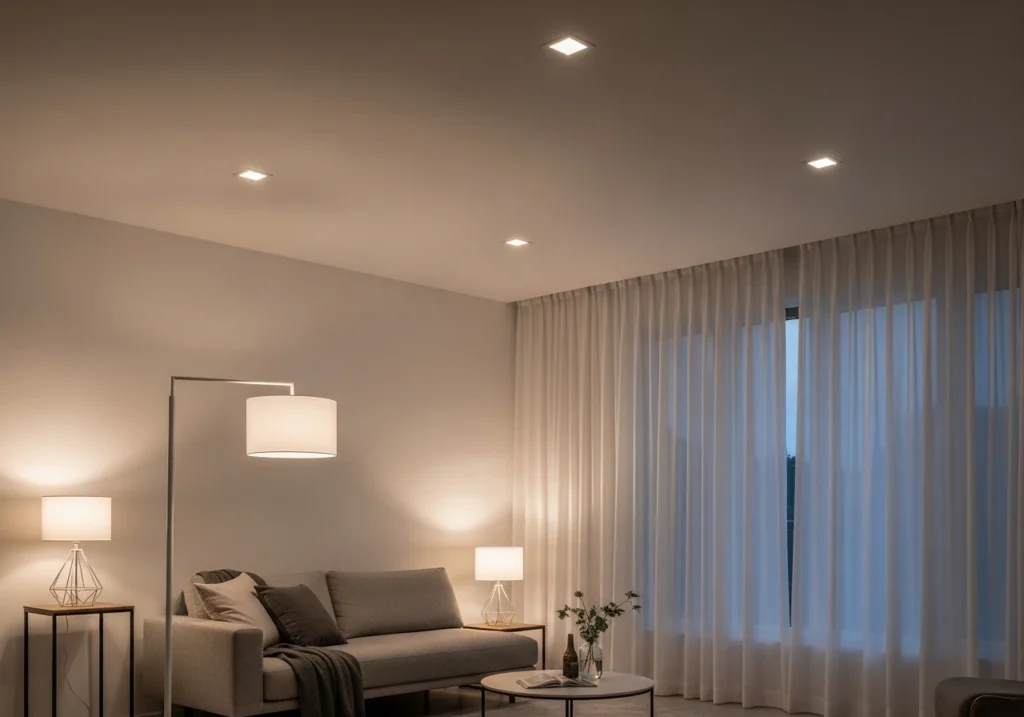
Lighting plays a crucial role in minimalist living rooms, both as a functional necessity and a design element. The goal is to create layered lighting that can be adjusted for different moods and activities.
Natural Light: Maximize natural light whenever possible. Keep window treatments simple – consider:
- Sheer curtains that filter light without blocking it
- Simple roller blinds in neutral colors
- Minimal window frames that don’t detract from the view
Artificial Lighting: Create a layered lighting scheme with:
- Ambient lighting: Recessed ceiling lights or simple pendant lights
- Task lighting: Reading lamps and focused work lights
- Accent lighting: Table lamps or wall sconces that create visual interest
Choose fixtures with clean lines and simple forms. Avoid ornate chandeliers or busy lamp shades that compete for attention.
Textiles and Textures: Adding Warmth Without Clutter
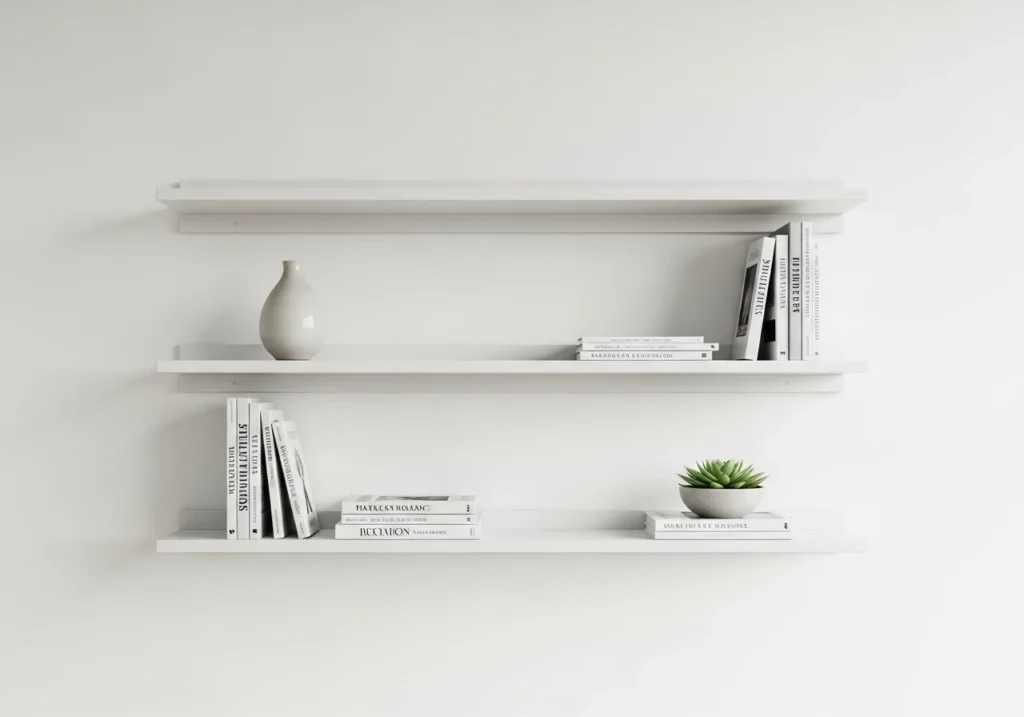
While minimalist design emphasizes clean lines and simplicity, incorporating varied textures prevents the space from feeling cold or sterile. The key is to use textiles strategically and sparingly.
Rugs: A well-chosen rug can anchor your seating area and add warmth to hard flooring. Select rugs with:
- Simple patterns or solid colors
- Natural materials like wool or jute
- Appropriate size that grounds your furniture grouping
Throw Pillows and Blankets: Add comfort and visual interest with:
- A limited number of throw pillows in coordinating colors
- One or two high-quality throws in natural materials
- Varied textures that complement your color scheme
Window Treatments: Keep window coverings simple and functional:
- Linen or cotton curtains in neutral tones
- Simple hardware that doesn’t compete with the overall design
- Consistent style throughout the room
Creating Your Minimalist Living Room: Step-by-Step Guide
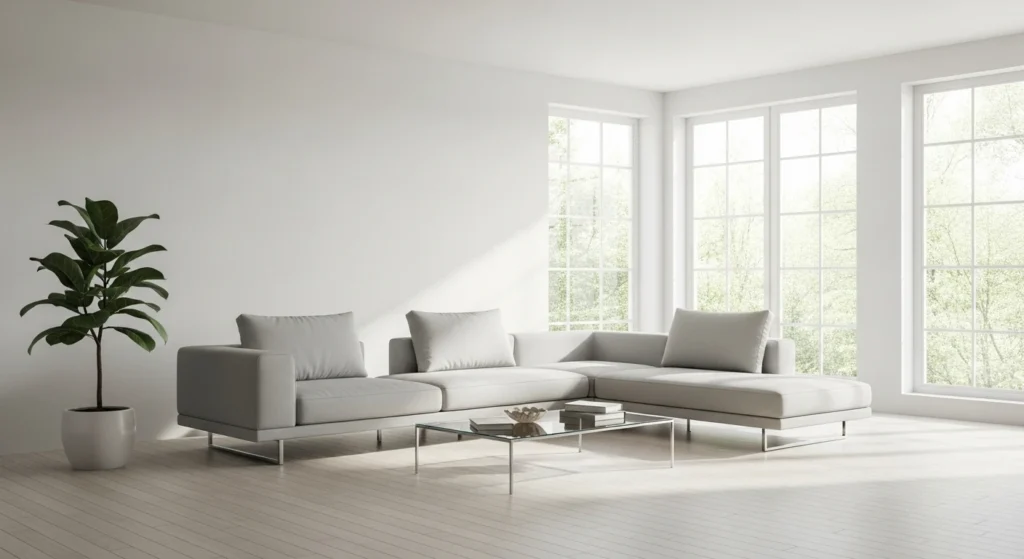
Step 1: Declutter and Assess
Begin by removing everything from your living room and honestly assessing each item. Ask yourself:
- Do I use this regularly?
- Does this item bring me joy or serve a specific purpose?
- Does it fit with my vision for a minimalist space?
Keep only items that pass this test, and find new homes for everything else through donation, sale, or storage in other areas of your home.
Step 2: Plan Your Layout
Consider how you use your living room and plan your layout accordingly. Create clear pathways and ensure that furniture placement promotes conversation and comfort. Remember that negative space is just as important as the furniture itself.
Step 3: Choose Your Color Scheme
Select a neutral base color for walls and major furniture pieces, then choose one or two accent colors for smaller elements. Stick to this palette throughout the room to maintain visual cohesion.
Step 4: Invest in Key Pieces
Purchase your major furniture pieces first – sofa, coffee table, and primary storage solutions. Choose high-quality items that align with minimalist principles and will serve you well for years to come.
Step 5: Add Layers Thoughtfully
Incorporate lighting, textiles, and decorative elements gradually. Each addition should enhance the room’s functionality or beauty without creating visual clutter.
Common Minimalist Design Mistakes to Avoid
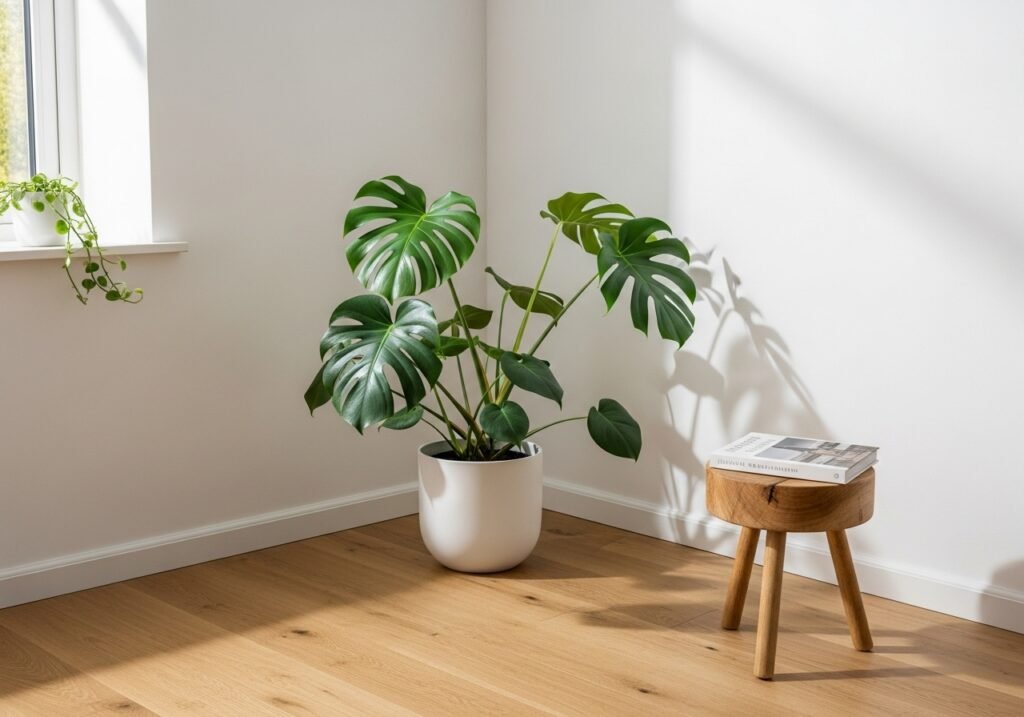
Confusing Minimalism with Stark or Cold
Minimalism doesn’t mean your living room should feel like a sterile showroom. Incorporate natural materials, varied textures, and warm lighting to create a space that feels inviting and lived-in.
Neglecting Storage Needs
Without adequate storage, even the most carefully curated space can quickly become cluttered. Plan for hidden storage solutions that keep everyday items organized and out of sight.
Choosing Furniture Based on Trends
Minimalist design emphasizes timeless appeal over trendy elements. Choose furniture and decor that will look relevant and beautiful for years to come, rather than following short-lived design fads.
Over-editing the Space
While minimalism champions the “less is more” philosophy, taking it too far can result in a space that feels empty rather than serene. Include enough elements to make the room feel complete and comfortable.
Maintaining Your Minimalist Living Room
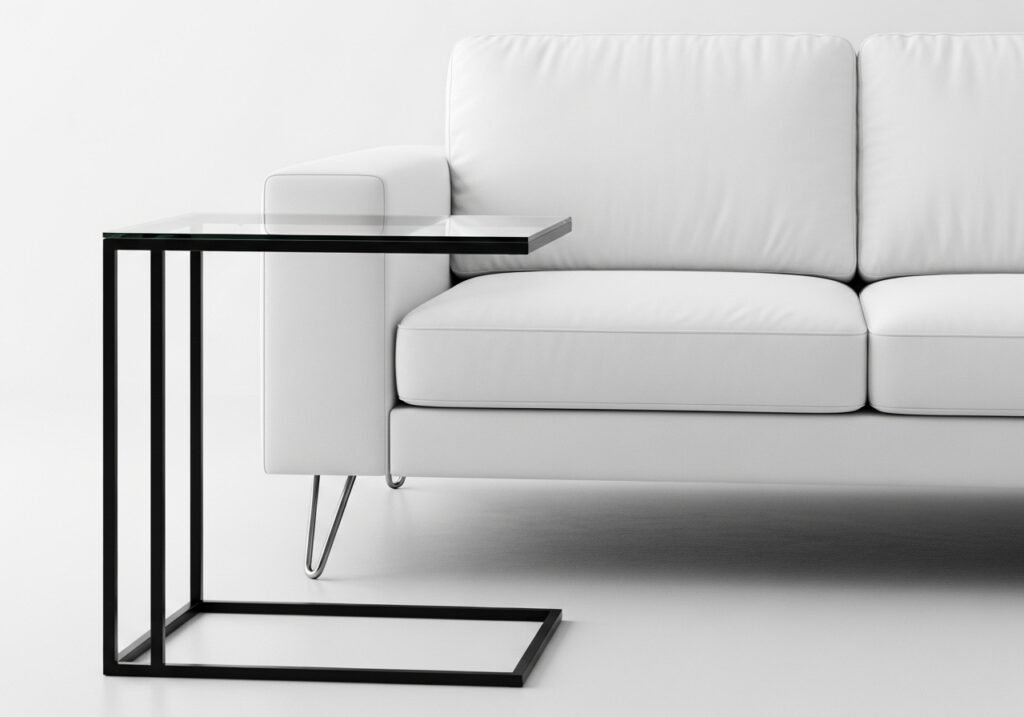
Creating a minimalist living room is just the beginning – maintaining it requires ongoing attention and discipline. Establish routines that support your minimalist goals:
- Implement a “one in, one out” policy for new purchases
- Schedule regular decluttering sessions
- Choose a designated place for everything and return items to their homes immediately after use
- Be selective about seasonal decorations and temporary additions
The Benefits of Minimalist Living Room Design
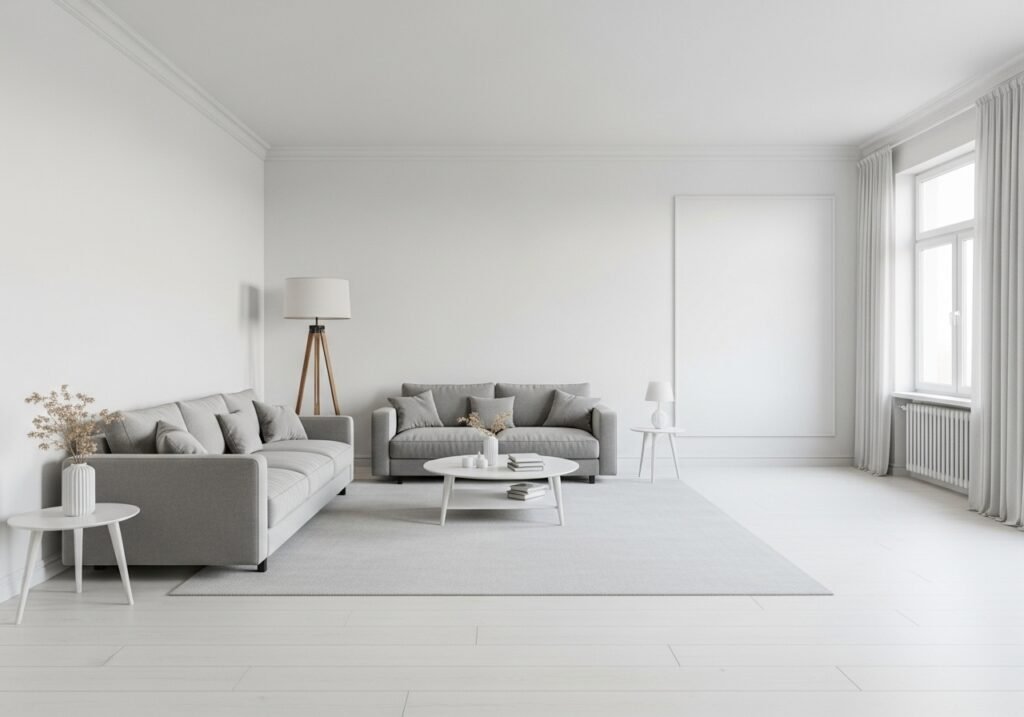
Embracing minimalist principles in your living room design offers numerous benefits beyond aesthetic appeal:
Reduced Stress: Clutter has been scientifically proven to increase cortisol levels and create feelings of anxiety. A clean, organized space promotes mental clarity and relaxation.
Easier Maintenance: Fewer items mean less dusting, organizing, and cleaning. Your minimalist living room will be easier to maintain, giving you more time to enjoy the space.
Financial Benefits: By focusing on quality over quantity and avoiding impulse purchases, minimalist design can actually save money in the long run.
Improved Focus: A calm, uncluttered environment supports concentration and mindfulness, whether you’re reading, working, or simply relaxing.
Enhanced Social Connection: Without visual distractions, minimalist living rooms naturally encourage conversation and human connection.
Conclusion
Minimalist living room design offers a path to creating a space that is both beautiful and functional, supporting a lifestyle of intentionality and calm. By focusing on quality pieces, neutral color palettes, and thoughtful curation, you can transform your living room into a peaceful retreat that serves your needs without overwhelming your senses.
Remember that minimalism is not about deprivation – it’s about making conscious choices that align with your values and lifestyle. Every element in your minimalist living room should serve a purpose and contribute to the overall sense of harmony and tranquility.
As you embark on your minimalist design journey, be patient with the process. True minimalist design takes time to achieve, as it requires thoughtful consideration of each element and how it contributes to the whole. The result, however, is a living space that supports well-being, promotes relaxation, and stands the test of time – a true sanctuary in our busy world.

